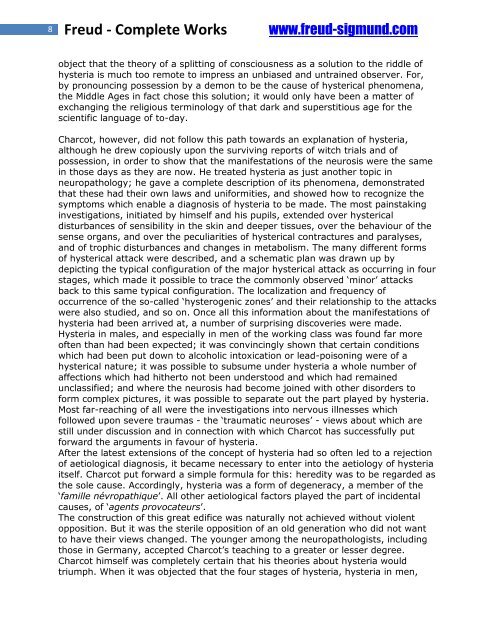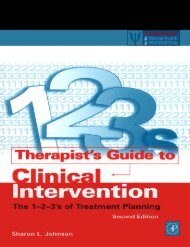Charcot - Sigmund Freud
Charcot - Sigmund Freud
Charcot - Sigmund Freud
You also want an ePaper? Increase the reach of your titles
YUMPU automatically turns print PDFs into web optimized ePapers that Google loves.
8 <strong>Freud</strong> - Complete Works www.freud-sigmund.com<br />
object that the theory of a splitting of consciousness as a solution to the riddle of<br />
hysteria is much too remote to impress an unbiased and untrained observer. For,<br />
by pronouncing possession by a demon to be the cause of hysterical phenomena,<br />
the Middle Ages in fact chose this solution; it would only have been a matter of<br />
exchanging the religious terminology of that dark and superstitious age for the<br />
scientific language of to-day.<br />
<strong>Charcot</strong>, however, did not follow this path towards an explanation of hysteria,<br />
although he drew copiously upon the surviving reports of witch trials and of<br />
possession, in order to show that the manifestations of the neurosis were the same<br />
in those days as they are now. He treated hysteria as just another topic in<br />
neuropathology; he gave a complete description of its phenomena, demonstrated<br />
that these had their own laws and uniformities, and showed how to recognize the<br />
symptoms which enable a diagnosis of hysteria to be made. The most painstaking<br />
investigations, initiated by himself and his pupils, extended over hysterical<br />
disturbances of sensibility in the skin and deeper tissues, over the behaviour of the<br />
sense organs, and over the peculiarities of hysterical contractures and paralyses,<br />
and of trophic disturbances and changes in metabolism. The many different forms<br />
of hysterical attack were described, and a schematic plan was drawn up by<br />
depicting the typical configuration of the major hysterical attack as occurring in four<br />
stages, which made it possible to trace the commonly observed ‘minor’ attacks<br />
back to this same typical configuration. The localization and frequency of<br />
occurrence of the so-called ‘hysterogenic zones’ and their relationship to the attacks<br />
were also studied, and so on. Once all this information about the manifestations of<br />
hysteria had been arrived at, a number of surprising discoveries were made.<br />
Hysteria in males, and especially in men of the working class was found far more<br />
often than had been expected; it was convincingly shown that certain conditions<br />
which had been put down to alcoholic intoxication or lead-poisoning were of a<br />
hysterical nature; it was possible to subsume under hysteria a whole number of<br />
affections which had hitherto not been understood and which had remained<br />
unclassified; and where the neurosis had become joined with other disorders to<br />
form complex pictures, it was possible to separate out the part played by hysteria.<br />
Most far-reaching of all were the investigations into nervous illnesses which<br />
followed upon severe traumas - the ‘traumatic neuroses’ - views about which are<br />
still under discussion and in connection with which <strong>Charcot</strong> has successfully put<br />
forward the arguments in favour of hysteria.<br />
After the latest extensions of the concept of hysteria had so often led to a rejection<br />
of aetiological diagnosis, it became necessary to enter into the aetiology of hysteria<br />
itself. <strong>Charcot</strong> put forward a simple formula for this: heredity was to be regarded as<br />
the sole cause. Accordingly, hysteria was a form of degeneracy, a member of the<br />
‘famille névropathique’. All other aetiological factors played the part of incidental<br />
causes, of ‘agents provocateurs’.<br />
The construction of this great edifice was naturally not achieved without violent<br />
opposition. But it was the sterile opposition of an old generation who did not want<br />
to have their views changed. The younger among the neuropathologists, including<br />
those in Germany, accepted <strong>Charcot</strong>’s teaching to a greater or lesser degree.<br />
<strong>Charcot</strong> himself was completely certain that his theories about hysteria would<br />
triumph. When it was objected that the four stages of hysteria, hysteria in men,



